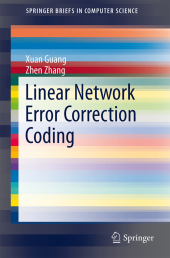 Neuerscheinungen 2014Stand: 2020-02-01 |
Schnellsuche
ISBN/Stichwort/Autor
|
Herderstraße 10
10625 Berlin
Tel.: 030 315 714 16
Fax 030 315 714 14
info@buchspektrum.de |

Xuan Guang, Zhen Zhang
(Beteiligte)
Linear Network Error Correction Coding
2014. 2014. vi, 107 S. 9 SW-Abb. 235 mm
Verlag/Jahr: SPRINGER, BERLIN; SPRINGER NEW YORK 2014
ISBN: 1-493-90587-2 (1493905872)
Neue ISBN: 978-1-493-90587-4 (9781493905874)
Preis und Lieferzeit: Bitte klicken
There are two main approaches in the theory of network error correction coding. In this SpringerBrief, the authors summarize some of the most important contributions following the classic approach, which represents messages by sequences similar to algebraic coding, and also briefly discuss the main results following the other approach, that uses the theory of rank metric codes for network error correction of representing messages by subspaces.
This book starts by establishing the basic linear network error correction (LNEC) model and then characterizes two equivalent descriptions. Distances and weights are defined in order to characterize the discrepancy of these two vectors and to measure the seriousness of errors. Similar to classical error-correcting codes, the authors also apply the minimum distance decoding principle to LNEC codes at each sink node, but use distinct distances. For this decoding principle, it is shown that the minimum distance of a LNEC code at each sink node can fully characterize its error-detecting, error-correcting and erasure-error-correcting capabilities with respect to the sink node. In addition, some important and useful coding bounds in classical coding theory are generalized to linear network error correction coding, including the Hamming bound, the Gilbert-Varshamov bound and the Singleton bound. Several constructive algorithms of LNEC codes are presented, particularly for LNEC MDS codes, along with an analysis of their performance. Random linear network error correction coding is feasible for noncoherent networks with errors. Its performance is investigated by estimating upper bounds on some failure probabilities by analyzing the information transmission and error correction. Finally, the basic theory of subspace codes is introduced including the encoding and decoding principle as well as the channel model, the bounds on subspace codes, code construction and decoding algorithms.
Introduction.- Network Error Correction Model.- Another Description of Linear Network Error Correction Model.- Coding Bounds of Linear Network Error Correction Codes.- Random Linear Network Error Correction Coding.- Subspace Codes.
From the book reviews:
"This short book on linear network error-correcting codes is a timely introductory review of a specific area of NC. ... for subject experts, it does provide quick reading material on the main concepts in network error correction. Readers can quickly grasp the new research area and start working on problems of interest." (Manish Gupta, Computing Reviews, December, 2014)


